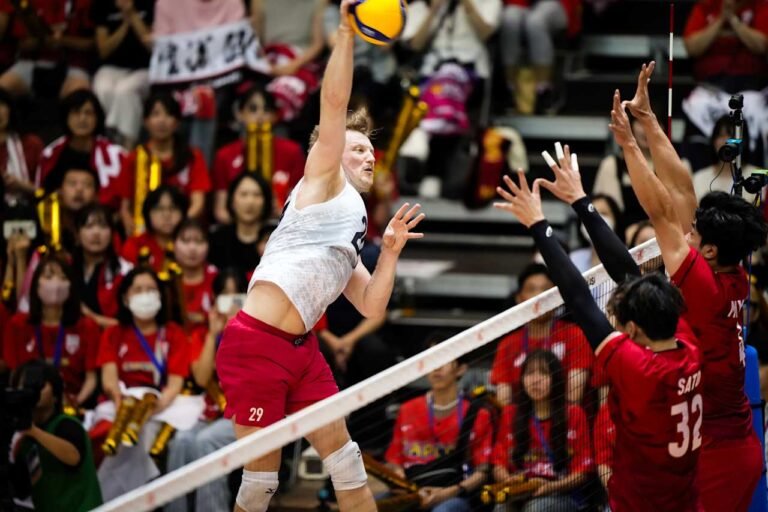Headline:
U.S. Men’s Volleyball Team Falls to Japan in 2025 VNL Finale, Ending Tournament on Disappointing Note…read more…
The U.S. Men’s National Volleyball Team concluded its 2025 Volleyball Nations League (VNL) campaign with a tough four-set loss to Japan, marking a bittersweet end to a tournament filled with highs and lows. The 3-1 defeat (25-20, 22-25, 25-23, 25-21) in the final match of the competition not only underscored Japan’s consistency and growing power in international volleyball but also highlighted some persistent weaknesses in the American side that will need addressing ahead of the 2025 FIVB World Championship.
Struggles in Consistency
From the first whistle, Japan displayed the composure and pace that has defined their VNL journey. The opening set saw them race out to an early lead, capitalizing on precise service pressure and relentless defense. The U.S. struggled to find rhythm, committing a handful of early errors and failing to slow down Japan’s quick offensive combinations. Despite a few bright moments from veteran outside hitter Aaron Russell and middle blocker David Smith, the Americans fell 25-20.
The second set showed flashes of the team the U.S. can be when all cylinders are firing. Setter Micah Christenson orchestrated a more dynamic offense, spreading the ball efficiently between the wings and middle. Matt Anderson, returning to the lineup after sitting out a few matches earlier in the tournament, hammered home a team-high 18 points. The Americans edged out the set 25-22, tying the match and momentarily swinging momentum in their favor.
Japan’s Efficiency and Depth
Japan, however, responded with the maturity and tactical sharpness that have seen them climb steadily in world rankings. Led by captain and outside hitter Yuki Ishikawa, who finished with 19 points, Japan weathered every American surge with smart attacking choices and impenetrable backcourt coverage. Libero Tomohiro Ogawa put on a defensive clinic, turning potential U.S. kills into counterattacks that often ended in Japanese points.
The third set was the turning point. Both teams traded points closely, but a critical missed serve by the U.S. at 23-23 opened the door for Japan to snatch the set, 25-23. It was a crushing blow to an American team that had started to believe they could mount a comeback.
Missed Opportunities
Set four followed a similar pattern. The U.S. stayed within striking distance but never managed to take full control. Service errors plagued their momentum, and the block – a strength in earlier matches – was ineffective against Japan’s quick tempo and diverse attack. Japan closed out the final set 25-21, sealing a 3-1 victory and finishing the tournament on a high.
With this win, Japan concluded the VNL with a record of 10-2 in the preliminary phase and a third-place finish overall, signaling their increasing status as a serious medal contender at future major events. The U.S., meanwhile, exited in sixth place, unable to replicate the consistency that saw them reach the final in the 2023 edition.
Reflections from the U.S. Camp
“We know we’re capable of more,” said U.S. head coach John Speraw in the post-match press conference. “This tournament gave us valuable insight into where we’re strong and where we need to sharpen up, particularly in serve reception and transition defense. Japan played an exceptional match today – they’re one of the most disciplined teams in the world right now.”
Veteran opposite Matt Anderson echoed Speraw’s sentiments. “We’ve got the talent, but we lacked execution in key moments,” he said. “Now we look forward. We’ll regroup, recover, and prepare for the World Championship.”
Youth Movement and Rotational Shifts
One of the positive takeaways from this year’s VNL campaign was the emergence of several young players stepping into bigger roles. Outside hitter Brett Wildman, in only his second full season with the senior national team, had breakout performances earlier in the tournament. Middle blocker Tyler Mitchem also showed potential, providing blocking presence and energy off the bench.
Coach Speraw made it clear that the VNL was an opportunity to test lineups and combinations ahead of bigger challenges. However, the lack of lineup stability may have cost the U.S. some continuity in rhythm and on-court chemistry.
What’s Next?
The U.S. now shifts focus to the 2025 FIVB Men’s World Championship, scheduled for later this fall. With an eye on Olympic qualification rankings and overall team development, the VNL served as both a measuring stick and a lesson in execution under pressure.
Key areas for improvement include limiting unforced errors, improving first contact in serve receive, and reinforcing communication in defensive transitions. While the tools are clearly there – from the world-class setting of Christenson to the offensive prowess of Anderson and Russell – converting talent into results will be the challenge moving forward.
Final Thoughts
While the U.S. Men’s National Team finishes the 2025 VNL without a medal and with a disappointing end, the competition provided critical experience for both veterans and rising stars. The loss to Japan, a team that continues to prove it belongs among the world’s elite, highlighted how narrow the margin for error is at the top level of men’s volleyball.
As the team regroups for its next phase of international play, fans and analysts alike will be watching to see how the U.S. adjusts and evolves. The potential remains immense – but it must be unlocked through discipline, shar
per execution, and a renewed sense of urgency.



